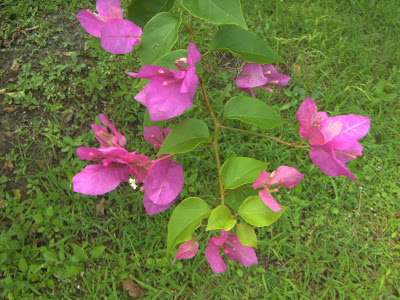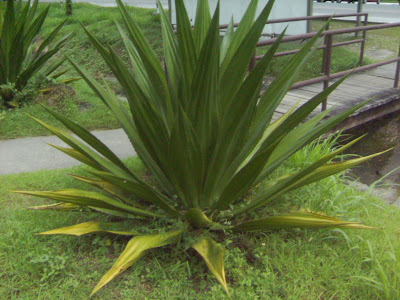Plant #1: Bougainvillea - Bougainvillea glabra
Bougainvillea is a popular woody scandent shrub. It grows to the height of 10 -15 feet. The flowers are classic red, purple, orange, white, pink and cream, which bloom all year. The leaves are ovate, rich green or variegated, colorful bracts surrounding small tubular flowers. The woody trunk tends to be twisted and the stem have sharp thorns and dark green leaves.
Plant #2: Santan - Ixora grandiflora Ker
Santan is a genus of flowering plans in the Rubiaceae family. It consists of tropical evergreen trees and shrubs and holds around 500 species. The plant possesses leathery leaves, ranging from 3 to 6 inches in length, and produce large clusters of tiny flowers in the summer. Members of Ixora prefer acidic soil, and are suitable choices for bonsai. It is also a popular choice for hedges in parts of South East Asia, like in Thailand. In tropical climates they flower year round.
Plant #3: Gumamela - Hibiscus rosa-sinensis Linn
Gumamela is highly cultivated as an ornamental plant in the Philippines. This plant usually grows from one meter up to four meters high. Its flower may come in various colors like orange, pink, yellow, red, etc.Gumamela can be used as herbal medicine.
Plant #4: Periwinkle - Catharantus roseus
Rose periwinkle is a commonly cultivated Old World woody herb having large pinkish to red flowers. It is an evergreen subshrub or herbaceous plant growing to 1 m tall. The leaves are oval to oblong, 2.5–9 cm long and 1–3.5 cm broad, glossy green, hairless, with a pale midrib and a short petiole 1–1.8 cm long; they are arranged in opposite pairs. The flowers are white to dark pink.
Plant #5: Makahiya - Mimosa pudica
Mimosa pudica (pudica is a Latin word meaning "shy, bashful or shrinking"), is a creeping annual or perennial herb often grown for its curiosity value: the compound leaves fold inward and droop when touched or shaken, re-opening minutes later. The stem of this plant is erect, but becomes creeping or trailing with age. The stem is slender, branching, and sparsely to densely prickly, growing to a length of 1.5 m. The leaves of the makahiya are compound leaves. The leaves are bipinnately compound, with one or two pinnae pairs, and 10-26 leaflets per pinna. The petioles are also prickly. Pale pink or purple flowers arise from the leaf axils.
Plant #6: Balete - Ficus elastica
Balete or Ficus elastica, also called the rubber fig, rubber bush, rubber tree, rubber plant, or Indian rubber bush is a species of plant in the fig genus, native to northeast India and southern Indonesia. it can grow to 30 - 40 meters, with a stout trunk up to 2 meters diameter.
Plant #7: Fern - Cyathea spp.
A fern is any one of a group of about 12,000 species of plants belonging to the botanical group known as Pteridophyta. Unlike mosses, it has xylem and phloem. It has stems, leaves, and roots like other vascular plants. Ferns reproduce via spores and have neither seeds nor flowers.
Plant #8:Dumb Cane - Dieffenbachia amoena
Dumb cane is a monocot which is commonly cultivated as a houseplant, for its decorative leaves. It is a very popular and hardy shade-loving plant. Its leaves are large, oblong, and cream or light yellow with deep green spots and stripes in bands along the veins and border.It can be propagated by tip and nodal cuttings. It can attain a height of 6 feet in favorable condition.
Plant #9:Snake Plant - Sansevieria trifasciata
Snake plant is a species of Sansevieria, native to tropical West Africa from Nigeria. It is an evergreen herbaceous perennial plant forming dense stands, spreading by way of its creeping rhizome, which is sometimes above ground, sometimes underground. Its stiff leaves grow vertically from a basal rosette. Mature leaves are dark green with light gray-green cross-banding and usually range between 70–90 cm in length and 5–6 cm in width.
Plant #10
Plant #11: The Weeping Fig - Ficus benjamina
Ficus benjamina, commonly known as the Weeping Fig, Benjamin's Fig, or the Ficus Tree and often sold in stores as just a "Ficus", is a species of fig tree, native to south and southeast Asia and Australia. It is the official tree of Bangkok, Thailand. It is a topiary tree reaching 30 meters tall in natural conditions, with gracefully drooping branchlets and glossy leaves 6–13 cm long, oval with an acuminate tip.
Plant #12: Striped Dracaena or Dracaena Ulises - Dracaena deremensis Ulises
This plant, named as “Ulises”, is characterized by its compact and vigorous growth. It has a distinct leaf color. Its concave leaves are tough and thick and are slightly bent downwards. Each of the variegated glossy leaves have dark green margin with green to grey-green center. Between the margin and the leaf center is a white area. Dracaena Ulises stem is green in color with yellow-green and grey-green markings.
Ulises is great as a potted plant of when grown in containers. Its bushy and upright growth form can add class to any space or room. Its resistance against environmental stresses and diseases were noteworthy and are notably different from the rest of the Dracaena plants.
Plant #13:Song of India - Dracaena reflexa
Song of India, or Dracaena reflexa, is a species of Dracaena which is a tropical tree native to Madagascar, Mauritius, and other nearby islands of the Indian Ocean. It is widely grown as an ornamental plant and houseplant, valued for its richly coloured, evergreen leaves, and thick, irregular stems. While it may reach a height of 4–5 m, rarely 6 m in ideal, protected locations, D. reflexa is usually much smaller, especially when grown as a houseplant. It is slow-growing and upright in habit, tending to an oval shape with an open crown. The lanceolate leaves are simple, spirally arranged, 5–20 cm long and 1.5-5 cm broad at the base, with a parallel venation and entire margin; they grow in tight whorls and are a uniform dark green.
Plant #14: Umbrella Tree (Talisai) - Terminalia catappa
The Talisai tree, came from the family Combretaceae, also known as the Indian Almond or Umbrella tree is a common tree that is often found along coastal areas, roadsides and parks. Being in this type of habitat, this tree is salt and drought tolerant, best grown under full sun and is also resilient to strong winds during the rainy season. Often planted as a shade and ornamental tree due to it's large broad leaves and branches that extend horizontally, which then form tiers or levels. This tree would certainly help provide protection and shelter for any passers-by.
Plant #15: Macarthur Tree - Ptychosperma macarthurii
Macarthur tree is an evergreen clustering palm of variable height that can grow up to 9.1 m tall, but generally grows between 3-6 m in height, with a spread between 1.8-3 m. It can be planted singly or in groups. It is typically multi-trunked, with impressive clumps of upright and slender stems that are grey-colored and ringed by leaf scars. the leafs which are medium to dark green in color, are linear-shaped and up to 30 cm long, with jagged tips or seemingly torn ends.
Plant #16
Plant #17:Bermuda grass - Cynodon dactylon
Cynodon dactylon, also known as Dūrvā Grass,Bermuda Grass, Dubo, Dog's Tooth Grass, Bahama Grass, Devil's Grass, Couch Grass,Indian Doab, Arugampul, Grama, and Scutch Grass, is a grass native to north and east Africa, Asia, and Australia and southern Europe. Although it is not native to Bermuda, it is an abundant invasive species there. It is presumed to have arrived in North America from Bermuda, resulting in its common name.
The blades are a grey-green colour and are short, usually 2–15 centimeters long with rough edges and the erect stems can grow 1–30 centimeters tall. The stems are slightly flattened, often tinged purple in color. It has a deep root system; in drought situations with penetrable soil, the root system can grow to over 2 m deep, though most of the root mass is less than 60 cm under the surface. The grass creeps along the ground and root wherever a node touches the ground, forming a dense mat.
Plant #18: Ebak Tree - Sterculia foetida
Sterculia foetida, known as Kalumpang or Ebak tree, is a large, straight, deciduous tree growing to 40 m in height and 3 m in girth, with the branches arranged in whorls and spreading horizontally. It is a tall, straight, noble tree, transcendent in the fresh, full leafage of March and April. This tree originated from East Africa and North Australia and it also grows in the West of the Peninsular, in Burma and Ceylon.The bark, which is colored grey, is smooth, spotted with brown and faintly ridged. The branches are whorled and usually horizontal, the numerous branchlets gracefully up-curved and crowded at the ends with large, digitate leaves. The leaves which spring in groups of about seven from the ends of the branchlets are born on long stalks and consist of from five to seven 6-inch leaflets issuing from a central point - a hand-like formation. The crimson-brown flowers of this tree are formed at the knotty ends of the wrinkled old branchlets spread in drooping rays. The calices, in appearance like petals, of which there are none apparent, are about 1-inch across, five-sepalled, back-curling and varying in colour from yellow to pale terracotta and to deep crimson and brown. This tree is also known for emitting an unpleasant odor especially during the month of February and March.
Plant #19: Bamboo Palm - Chamaedorea seifrizii
Chamaedorea species are small palms, growing to 0.3–6 m tall with slender, cane-like stems, growing in the understory in rainforests, and often spreading by means of underground runners, forming clonal colonies. The leaves are pinnate (rarely entire), with one to numerous leaflets. The flowers are produced in inflorescences; they are dioecious, with male and female flowers on separate plants. The fruit is an orange or red drupe 0.5–2 cm diameter. It is popular as a houseplant.
Plant #20: Yucca - Yucca brevifolia
Yucca brevifolia is a plant species belonging to the genus Yucca. It is tree-like in habit, which is reflected in its common names: Joshua tree, Yucca palm, Tree yucca, and Palm tree yucca. This monocotyledonous tree is native to southwestern North America in the states of California, Arizona, Utah and Nevada, where it is confined mostly to the Mojave Desert between 400 and 1,800 meters elevation. It thrives in the open grasslands of Queen Valley and Lost Horse Valley in Joshua Tree National Park.
Yucca tree has stiff, succulent, perennial leaves and produce creamy-white, waxy flowers. They are found in the higher elevations of many of the North and Central American deserts, and they can be tolerant of cold weather. There are many species of Yucca and they are difficult to distinguish from others; however, some are identifiable because of their distinct characteristics.





















No comments:
Post a Comment